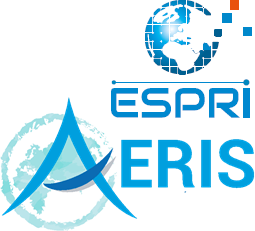
Centre de Données ESPRI (ex. Ether)
ESPRI est un centre de données du Pôle National Atmosphère AERIS
ESPRI est un centre de données du Pôle National Atmosphère AERIS

......................................
Accès aux données
.............................................
Contact & publications
......................................
Profils δD restitués a partir des spectres IASI (HDO/H2O)
Comment lire les données
|
Chaque fichier contient, pour un jour d’observation, les profils de HDO et H2O pour la zone des tropiques (30S-30N) et pour les orbites AM. Les noms de fichiers contiennent la date d’observation. Leur structure est : : Les données ont été produites par Jean-Lionel Lacour : Jean-Lionel.Lacour@latmos.ipsl.fr Le format des fichiers est du NetCFD4. Variables contenues dans les fichiers NetCDF : description observation_time_string - [nobs*16] char - ex: 20090131T003400Zorbit_number - [nobs] - int32 scanline_number - [nobs] - int32 pixel_number - [nobs] - int32 longitude - [nobs] – single – [-180°- 180°] latitude - [nobs] – single – [-90°- 90°] tsurf - [nobs] – single –[K] radiances_residual_mean - [nobs] – single – [W cm-1 sr-1 / cm-1] – mean of the residual of the fit radiances_residual_std - [nobs] – single – [W cm-1 sr-1 / cm-1] – standard deviation of the residual of the fit ampm_flag - [nobs] - int32 – 0=AM orbit; 1=PM orbit year - [nobs] - int32 month - [nobs] - int32 day - [nobs] - int32 hour - [nobs] - int32 minute - [nobs] - int32 AVK - [26*26*nobs] – Averaging kernels Aaa - [26*26*nobs] – Averaging kernels after a posteriori correction (type 2) spectra_observed – [nobs*233] spectra_calculated – [nobs*233] hdo_profiles – [13*nobs] - hdo profiles not to be used hdo_bc_profiles – [13*nobs] – hdo profiles type 1 – to be used to compute delta D h2o_profiles – [13*nobs] – h2o profiles type 1– to be used to compute delta D h2o_t2 – [13*nobs] – h2o profiles type 2 dd_t2 – [13*nobs] – δD profiles type 2 pressure_profiles – [13*nobs] temperature_profiles – [13*nobs] alt_asl – [13*nobs] – altitude above sea levels altitude_levels – [13] – altitude levels above ground wavenumbers – [233] Retrieval methodology (in english) To retrieve δD from IASI spectral radiances, we used the optimal estimation method, mainly following the approach proposed by Worden et al. (2006) and Schneider et al. (2006). It involves retrieving HDO and H2O with an a priori covariance matrix that represents the variability of the two species but also contains information on the correlations between them. The retrieval performed on a log scale allows better constraint of the solution and minimization of error on the δD profile (Worden et al., 2006; Schneider et al., 2006; Schneider and Hase, 2011). The line-by-line radiative transfer model software Atmosphit developed at the Université Libre de has been adapted to allow this HDO/H2O correlated approach. Using correlations between log(HDO) and log(H2O) helps to constrain the joint HDO/H2O retrieval to a physically meaningful solution.Considering the limited vertical sensitivity of retrieval The error of a retrieval can be separated into 3 principal components:(1) the smoothing error, (2) the error due to uncertainties in model parameters, and (3) the error due to the measurement noise. The smoothing error is generally the largest error. Following this, there are two ways to conduct an error analysis (EA), depending whether one considers the retrieval as an estimate of the true state with an error contribution due to smoothing (EA1), or as an estimate of the true state smoothed by the averaging kernels (EA2). Averaging kernels type 1 The averaging kernels describe the sensitivity of the retrieval to the true variation of the state of the atmosphere. In the δD retrieval the averaging kernels are regrouped in 26*26 matrix which are composed of 4 sub-blocks. Each sub-block is a 13*13 matrix: -Ahh corresponds to the sensitivity of the retrieved humidity profile to real variations of humidity -Add corresponds to the sensitivity of the retrieved HDO profile to real variations of HDO -Ahd corresponds to the sensitivity of the retrieved humidity profile to real variations of HDO -Adh corresponds to the sensitivity of the retrieved HDO profile to real variations of humidity The corresponding δD profile is computed from variables hdo_bc_profiles and h2o_profiles:  Averaging kernels type 2 As there is more vertical information in the retrieved profile of humidity than HDO, there is a difference in vertical sensitivity between the humidity and δD profiles. For this reason, Wiegele et al., introduced a methodology to a posteriori correct the difference of vertical sensitivities in order to ensure that both humidity profile and δD profile are representative of the exact atmosphere. This a posteriori correction is provided in the netcdf files. When considering this approach, variables Aaa, h2o_t2 and dd_t2 must be used. The humidity profiles have been degraded to the vertical sensitivity of δD and Aaa (same structure than AVK) describe this sensitivity. The sub-blocks Ahh and Add are in that case identical. For simplicity it is recommended to use this type 2 product.Error analysis 2: considering the retrieval as an estimate of the true state smoothed by the averaging kernels This is the ideal approach. In comparisons model – data, this approach should be used. The error to consider in that case is the error due to uncertainties in model parameters (2) and the error due to the measurement noise (3). The resulting error has been estimated to 38 permil (between 3 and 6 km) on an individual basis. When considering several measurements, this error which is random can be reduced by a factor sqrt(n) with n being the number of measurements used in the averaging.To compare model to data using this approach it is necessary to degrade the vertical information contained in model profiles to the limited sensitivity of the retrieval. This can be easily achieved with the averaging kernels matrix: For the humidity profile: First the model profiles need to be interpolated at IASI vertical grid. Then the interpolated q (humidity) profile can be smoothed:  qsm=smoothed profile of q, Ahh=Averaging kernels corresponding to the retrieval of humidity (AVK(1:13,1:13)), q=model humidity profile interpolated at the retrieval levels, In= identity matrix, qp= a priori specific humidity profile used in the retrieval. The same approach applies for an optimal use of humidity and δD profiles (type 2). In that case, the matrix Aaa must be used. Error analysis 1: considering the retrieval as an estimate of the true state with an error contribution due to smoothing If δD retrievals are used in other context that model-data comparison or when the smoothing is not possible, it is important to keep in mind the limited information contained in the retrieved profile. For example, if δD observations at 3.5 km are used in parallel to airmass trajectory analysis it is important to consider the trajectory of the airmasses arriving between 2 and 5 km and not only at 3.5 km.Schneider, M., Wiegele, A., Barthlott, S., González, Y., Christner, E., Dyroff, C., García, O. E., Hase, F., Blumenstock, T., Sepúlveda, E., Mengistu Tsidu, G., Takele Kenea, S., Rodríguez, S., and Andrey, J.: Accomplishments of the MUSICA project to provide accurate, long-term, global and high-resolution observations of tropospheric {H2O,δD} pairs – a review, Atmos. Meas. Tech., 9, 2845-2875, https://doi.org/10.5194/amt-9-2845-2016, 2016. Wiegele, A., Schneider, M., Hase, F., Barthlott, S., García, O. E., Sepúlveda, E., González, Y., Blumenstock, T., Raffalski, U., Gisi, M., and Kohlhepp, R.: The MUSICA MetOp/IASI H2O and δD products: characterisation and long-term comparison to NDACC/FTIR data, Atmos. Meas. Tech., 7, 2719-2732, https://doi.org/10.5194/amt-7-2719-2014, 2014. |


